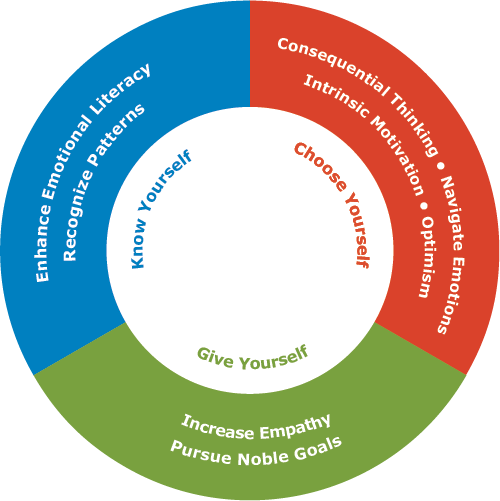How to Fire Someone with Emotional Intelligence
Firing someone is emotionally challenging, and easily one of the hardest aspects of leadership. Here are practical emotional intelligence tips to do it with compassion, clarity and calm.
By Michael Miller – November 15th, 2019

There are few aspects of leadership as emotionally challenging as letting someone go. How can we deal effectively with the emotional part of this challenge? Let’s apply the KCG Model of Emotional Intelligence to look at yourself in this process and how you want to show up as a person and as a leader.
Here are 3 expert tips for how to fire someone with emotional intelligence:
1. Perform the emotional labor to prepare yourself
“The first step is to check in with yourself,” says Natalie Roitman, Six Seconds Regional Network Director for Greater China, “Ask yourself: How am I feeling? Am I frustrated, angry, livid? You need to work through those feelings with yourself first, or you will likely dump those feelings on the person, compounding an already challenging situation.”
Jayne Morrison, Six Seconds Regional Network Director for the Middle East, India and Africa, agrees. “If you’ve reached this point where terminating the employee has become necessary, you’ve probably experienced a lot of frustration. But you just can’t bring that frustration into the conversation.” She says it’s essential to come to peace with what you have to do before you do it: “Accept responsibility for whatever part you could have done better. Accept that they’ve done the best they could with the knowledge, awareness and experiences that they have. Accept that they may not see things the same way. Ultimately, try to reach the point of forgiveness where you truly wish them the best in whatever they do next, and you’re not using this time to vent or blame.”
There are two EQ skills in action here. The first is enhancing emotional literacy, which is your ability to recognize and label emotions. The second is navigating emotions, which is the ability to assess, harness and transform emotions as a strategic resource. It’s crucial to do them before you sit down for this conversation, and inevitably, during it.
2. Recognize and navigate your stress reaction patterns
How do you normally react in uncomfortable situations? Take a minute to think about it. Typical responses include rambling on, blaming, even laughing… and on the other end of the spectrum, shutting down, blaming yourself, and apologizing repeatedly. Either end of the spectrum can make a bad situation worse. Be aware of how you might react, and consciously choose to not follow that pattern. That’s emotionally intelligent leadership.
Personally, I tend to give up too much power. I apologize too much, and enter into negotiations that I don’t want to be in. If you tend to apologize like this, Natalie says, you may want to consider what’s really behind that: “Ask yourself: Am I really sorry, or am I just trying to mitigate my discomfort? Because by apologizing repeatedly and undermining your position, you will probably cause more pain, confusion and discomfort in the long run.”
If you tend to go in the other direction, to ramble on and on or even to blame, focus on taking deep breaths and staying on message. Take pauses.
Firing someone is uncomfortable. That isn’t changing. But what you can change is your response patterns in uncomfortable situations, so you don’t get stuck on “autopilot” and instead your actions are aligned with your purpose.
3. Connect to your why and the human being across from you
“You must be clear about your why,” Morrison says. “You have to come to terms with why you’re doing this. If you’ve taken the small steps along the way to communicate effectively and try to find solutions, the why should be pretty clear to both parties, but at a minimum, you have to have that clarity for yourself.” If you’ve taken care of your why, and done the internal work, you don’t need to be volatile and reactive. You can be calm, clear and compassionate.
Remember: Emotional intelligence isn’t about being nice. It’s about being effective with emotions. Sometimes moving forward means going in different directions. With that said, a job is someone’s livelihood. Letting them go is a big deal, and it’s essential to empathize with what they are going through. It can be tempting in difficult situations to ignore or minimize our own feelings – or the other person’s – to avoid discomfort. Emotionally intelligent leadership is about using emotions as a resource – as a way to connect and achieve your goals – and that requires leaning into discomfort.
Want to infuse your organization with emotional intelligent leadership?
Download our free eBook for L&D Professionals
What’s new in emotional intelligence?
How to Thrive in a BANI World: Insights from the World’s Largest Study of Emotional Intelligence
Emotional intelligence is declining just when we need it most. Drawing from the the world’s largest EQ study, this article explores why and how to reverse the trend—with women leading the way toward emotionally intelligent leadership.
Why True Leaders Must Think Like Trainers: How to Use Emotional Intelligence to Excel in a Leadership Role
Discover how Emotional Intelligence and a trainer’s mindset can transform leadership, fostering growth, autonomy, and long-term success.
The Six Seconds Model of Emotional Intelligence: What It Is and How to Use It (+ PDF)
What is emotional intelligence and how do you practice it? Explore the Six Seconds Model of Emotional Intelligence to improve your life and relationships.
Unlocking Performance 2.0: Why Emotional Intelligence Is the Key to Leading in a BANI World
Are we looking for solutions in the right place? What if the key to success isn’t stricter control and efficiency, but more empathy and trust?
AI Fakes It: Good Leaders Keep It Real
We tested top GenAI models’ emotional intelligence—what we found reveals insights that every leader needs to know and will change the way you lead in an AI-powered world.
Plutchik’s Wheel of Emotions: Feelings Wheel
Grow your emotional literacy with Plutchik’s Wheel of Emotions. Then download the free Practicing Emotional Intelligence eBook to go deeper!
- Pursue Noble Goals in the Six Seconds Model of EQ - July 29, 2023
- Increase Empathy in the Six Seconds Model of EQ - July 26, 2023
- Exercise Optimism - July 24, 2023






